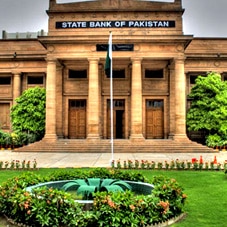
A Quick Note on SBP Announcement (Blog)
State Bank of Pakistan (SBP) announced three measures in its monetary policy statements to address the economic and recent health challenges in the backdrop of spread of COVID-19. First, it cut its policy rate by 75 basis points. Second, it announced a “Temporary Economic Refinance Facility (TERF)” to encourage new investment in manufacturing. Third, it announced a “Refinance Facility for Combating COVID–19 (RFCC)” to support hospitals and medical centers in combating the spread of COVID–19.
The cut in policy rate was expected due to four important domestic and international reasons. First, the arrival of domestic supplies of food commodities led to recent deceleration in their domestic prices. Second, a significant decline in consumer price expectations based of expectation surveys of SBP. Third, a sharp fall in global oil prices. Fourth, last but not the least, is the slowdown in external and domestic demand due to the COVID-19 pandemic. Lowering of the policy rate was inevitable, but the size of cut needs further discussion.
The current cut in policy rate is minimal as compare to the other regional economies which announced their monetary policy decisions recently (see Table 1)[1]. Therefore, majority of private sector investors were expecting a much more aggressive response from the SBP. The average of percentage change of all cuts is around 30 percent (see Table 1). Therefore, one may argue that the SBP should give a cut of 400 basis points which the 30 percent of 13.25. However, the current SBP decision is very conservative due to uncertain situation domestic and globally.
Table 1: Interest Rate Changes in Recent Monetary Policies
| Country | Previous Policy Rate | Current Policy Rate | Cut in Policy Rate | Percentage change |
| Australia | 0.75 | 0.50 | 0.25 | 33.33 |
| Hong Kong | 1.50 | 0.90 | 0.60 | 40.00 |
| Indonesia | 5.00 | 4.75 | 0.25 | 5.00 |
| Malaysia | 3.00 | 2.50 | 0.50 | 16.67 |
| New Zealand | 1.00 | 0.25 | 0.75 | 75.00 |
| Philippines | 4.00 | 3.75 | 0.25 | 6.25 |
| South Korea | 1.25 | 0.75 | 0.50 | 40.00 |
| Thailand | 1.25 | 1.00 | 0.25 | 20.00 |
| Average | — | — | — | 29.53 |
| Pakistan | 13.25 | 12.50 | 0.75 | 5.66 |
Note: Changes are mostly for March 2020
SBP on managing monetary policy amid fiscal rigidities and (in)stability of external account. For example, the portfolio investment (hot money) flows have become uncertain in the backdrop of interest rate risk and currency risk. Similarly, the worker remittances will get a sizable dip due to lower economic activities globally. In nutshell, the external account will remain vulnerable in coming days. Furthermore, the magnitude of damage from the COVID-19 pandemic is not clear. However, the initial projections and anecdotal analysis shows that the domestic demand, domestic supply and economic growth will be lower in FY 20.
Therefore, the SBP announces that ‘it stood ready to take further actions if and when needed as more information becomes available on the outlook for inflation and growth’. The sketchy analysis suggests that the time is not too far. We may expect 100 to 150 basis points in next policy review(s). However it is overwhelmingly dependent on the trajectory of external accounts in the coming weeks.
Second important things are TERF to new investment in manufacturing. Under this scheme, the SBP will refinance banks to provide financing at a maximum end-user rate of 7 percent for 10 years for setting up of new industrial units. This scheme is available for next one year, that is, the letter of credit must be opened by the end of March 2021. Apparently, it is an out of box thinking but seems in hurry in an uncertain and panic situation. It will create more confusion and uncertainty, at least, for one year. Just think in this way, the existing industrial units are getting finance at around 13 percent and new industrial units are offered 7 percent. Then how is it possible that the existing units get finance on the higher rates. Furthermore, it is a long term policy. At this crucial point of time, the economy needs short term impetus. Therefore, the SBP should think and disseminate more clearly and effectively. In conclusion, this brief note suggests that the SBP and government must move proactively to mitigate the damage towards the economy. It is important to disseminate a message that how the SBP is stand ready for mitigating the risk of COVID-19 pandemic. Several steps can be taken. For example, lower the interest rates by 300 to 400 bps. Make a clearer and a short term policy for financing to industrial units both for the existing and new industrial units. Immediately, rethink about the tax policy and documentation policy to avoid the stoppage of transactions in the economy. Furthermore, the government must immediately approach International Monetary Fund (IMF) to secure its share in the recently created ‘concessionary funding pool’ and adjusting targets of extended facility program. Indeed, all these steps are not easy, but a proactive approach will give confidence to economic agents of the country.
[1] The monetary policies of Indonesia and Philippines were announced in the start of February 2020 when the global pandemic was still getting underway.
A version of this blog was published in the Daily Times: https://dailytimes.com.pk/580009/a-quick-note-on-sbp-announcement/



